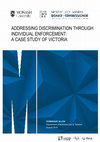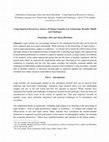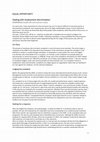Papers by Dominique Allen
Revue de droit comparé du travail et de la sécurité sociale

In Australia, anti-discrimination law is enforced by individuals who lodge a discrimination compl... more In Australia, anti-discrimination law is enforced by individuals who lodge a discrimination complaint at a statutory equality commission. The equality commission is responsible for handling complaints and attempting to resolve them. In most instances, the equality commission cannot advise or assist the complainant; it must remain neutral. In other countries, the equality commission plays a role in enforcement, principally by providing complainants with assistance to resolve their complaint including funding litigation. The equality commission's assistance function has been most effective when used strategically as part of a broader enforcement program, rather than on an ad hoc basis. This article discusses equality commission enforcement in the United States of America, Britain, Northern Ireland and Ireland and shows how the equality commissions in those countries have engaged in strategic enforcement in order to develop the law and secure remedies which benefit the wider commun...
Revue de droit comparé du travail et de la sécurité sociale, 2018
Workplace discrimination has been prohibited in Australia for over forty years. Until recently, i... more Workplace discrimination has been prohibited in Australia for over forty years. Until recently, it was the sole concern of anti-discrimination law; industrial relations law only prohibited dismissal on the basis of an irrelevant attribute, like sex and race. The Fair Work Act 2009 (Cth) ('FW Act') extended industrial relations law to other forms of discrimination, like demotion, and gave the Fair Work Ombudsman ('FWO') the power to enforce the law, something the agencies established under anti-discrimination laws have never been able to do.

Australian Health Review, 2021
Patients from racial/ethnic minority backgrounds can experience racism and race-based discriminat... more Patients from racial/ethnic minority backgrounds can experience racism and race-based discrimination in the health system, enduring unfair and inferior treatment that negatively affects physical and mental health and well-being and may, in some cases, lead to premature and avoidable death. Racism within the health system also acts as a deterrent to health care access because individuals may choose to avoid healthcare settings for fear of repeated exposure to racism. Racism and its impacts in health are well documented and health care-related regulatory organisations and antidiscrimination commissions in Australia are the recipients of racism complaints that occur within the health system. However, the extent and nature of complaints of racism in healthcare settings (i.e. self-reported incidents of racism) and how they are managed by regulatory organisations and antidiscrimination commissions are not well understood. This paper provides a summary of existing approaches to complaints in the Australian health system related to healthcare regulatory organisations and antidiscrimination commissions. We offer recommendations for improvements to data collection and dissemination of racism complaints to better understand the nature and extent of racism and race-based discrimination in the health system, and thus inform changes to process and practices that will reduce the incidence of racism and improve health outcomes.What is known about the topic?Patient complaints of racism in the health system are received by health care-related regulatory organisations and antidiscrimination commissions. However, the extent and nature of the complaints of racism in healthcare settings and how they are managed are not well understood.What does the paper add?This paper provides a summary of existing approaches to complaints in the Australian health system related to healthcare regulatory organisations and antidiscrimination commissions. We identify ways that existing complaints processes and mechanisms can be strengthened to enhance the safety and quality of patient care.What are the implications for practitioners?Practitioners, healthcare managers and policy makers can enhance existing complaints processes and mechanisms in order to improve the collection and use of healthcare racism complaints that can inform strategies to reduce healthcare racism and improve patient care.
Law in Context. A Socio-legal Journal, 2021
Although we live in an era in which government and private organisations collect large amounts of... more Although we live in an era in which government and private organisations collect large amounts of data, this has not filtered through to anti-discrimination and equality law in Australia. Government and its agencies have little incentive to collect information, nor does business. Neither group bears any obligation to tackle discrimination if they detect it. Yet the self-regulating enforcement model used in equality law is premised on the idea that information will be available to aid voluntary compliance. This article examines the nature of the data organisations that are currently required to collect and identify significant information gaps. It argues that it is not enough to simply fill those gaps with information; increased data collection needs to be accompanied by the obligation to address inequality if that is what the data reveals.

University of New South Wales Law Journal, 2018
The enactment of the Fair Work Act 2009 (Cth) (‘FWA’) gave employees a new mechanism for addressi... more The enactment of the Fair Work Act 2009 (Cth) (‘FWA’) gave employees a new mechanism for addressing workplace discrimination in addition to traditional anti-discrimination law. Section 351 of the FWA prohibits employers from taking adverse action against employees on a range of grounds including disability. This article evaluates whether section 351 can effectively address disability discrimination in the workplace. It argues that section 351 offers limited protection to employees with a disability because the FWA does not define ‘disability’, and the courts have interpreted ‘discrimination’ too narrowly to encompass the complexities of workplace discrimination. However, the FWA contains stronger enforcement mechanisms than anti-discrimination law so, with some refinements, it could offer employees with a disability a much more effective avenue for addressing discrimination than traditional anti-discrimination laws.

SSRN Electronic Journal, 2019
Victoria was one of the first States or Territories to prohibit discrimination when it enacted th... more Victoria was one of the first States or Territories to prohibit discrimination when it enacted the Equal Opportunity Act 1977 (Vic). Continuing to lead the way, in 2010 Victoria overhauled its anti-discrimination law after an extensive community consultation process. The Equal Opportunity Act 2010 (Vic) came into force in August 2011 and it stands as one of the most modern anti-discrimination laws in the country, with several innovative features including simplified definitions of discrimination, direct access to the tribunal for complainants, and a commitment to substantive equality. Anti-discrimination laws are similar throughout Australia. They rely on the individual who has experienced discrimination to lodge a claim and enforce their rights. Most claims are settled confidentiality through alternative dispute resolution or they are withdrawn. Consequently, very little is known about the nature of discrimination or how claims are resolved, and the body of case law that has developed over the last four decades is quite small. In 2016 I was awarded a grant by the Victorian Legal Services Board to conduct research on the innovative mechanisms in the Equal Opportunity Act 2010 (Vic) and to gather data about the resolution of discrimination complaints under the new system from key stakeholders. This report focuses on one aspect of that project-the process of resolving a discrimination claim. The report begins by setting the context for the introduction of the Equal Opportunity Act 2010 (Vic) and outlining the research methodology. The main part of the report presents the research findings as they apply to each stage of the dispute resolution process, from the decision about which jurisdiction to use, to lodgement at the Victorian Equal Opportunity and Human Rights Commission and/or the Victorian Civil and Administrative Tribunal, through to hearing. The report concludes with suggestions for how the dispute resolution and enforcement system could be

Griffith Law Review, 2018
Legal scholars are increasingly attuned to the substantial benefits that can be derived from empi... more Legal scholars are increasingly attuned to the substantial benefits that can be derived from empirical and socio-legal scholarship. While drawing on the knowledge of legal insiderssuch as legal practitioners, judges or academics-to critique and evaluate the effectiveness of law and legal reform is an established means of empirically evaluating legal impact, this approach can be particularly problematic in relation to empirical equality research, as legal insiders are unlikely to be members of the under-represented groups that are the focus of equality regulation, and are instead more likely to represent the majoritarian status quo. Drawing on two empirical projects conducted in Australia and the UK, this paper considers the benefits, potential pitfalls and challenges of undertaking empirical equality research in the workplace. Using an insider / outsider lens to facilitate analysis, it canvasses existing gaps in empirical equality law scholarship and considers how future research could address these limitations.

Alternative Law Journal, 2010
In late 2009, the National Human Rights Consultation Committee ('the Committee') released its muc... more In late 2009, the National Human Rights Consultation Committee ('the Committee') released its much anticipated report into protecting human rights in Australia.' Running at over 400 pages, the report was a blueprint for enhancing the protection of human rights including the recommendation that the federal government introduce a Human Rights Act.2 It is now part of history that, in 20 I 0, the then Rudd Government decided not to introduce a Human Rights Act. Instead, the government will introduce a human rights framework, which includes establishing a Parliamentary joint Committee on Human Rights and supporting human rights education. The government will review the framework's operation in 2014 and revisit the issue of human rights protection.3 During the Committee's nationwide consultation, and in the immediate aftermath of the report's release, there was a great deal of commentary from those for and against a Human Rights Act in the academic community, the media and elsewhere. The debate concerned the type of rights to protect, whether the 'dialogue' model was suitable for Australia, how best to protect the sovereignty of parliament and what the Committee termed 'hot button' topics, such as same-sex marriage and abortion. The role of the Australian Human Rights Commission ('AHRC') and how complaints about human rights violations should be resolved were largely absent from the debate. From the outset, it is worth highlighting that the Committee had a limited mandate. Due to the failure of Constitutional Bills of Rights in the past,~ and also possibly what Hilary Charlesworth terms Australia's 'reluctance about rights' ,5 the government did not permit the Committee to consider constitutionallyentrenched human rights protection. The Committee was left to consider a human rights statute and other reforms that would strengthen the democratic process.6 The recent popularity of the dialogue model ensured that it received the most attention. So-called because it sets up a dialogue between the courts, the legislature and the executive, the individual victim and the human rights institution appear to be silent participants in this conversation. During the consultation, little attention was devoted to the process of resolving a human rights violation, apart from the stage of a court hearing. As such, it was surprising that the Committee recommended an independent cause of action without considering the process of enforcing that right, particularly whether victims will be financially able to enforce their rights in the Federal Court under the other informal processes should be made available to them. However, the AHRC recommended that human rights complaints be dealt with in the same way as discrimination complaints, namely through its Alternative Dispute Resolution ('ADR') process but, as this article shows, aspects of this model have proved problematic in the anti-discrimination jurisdiction. This article examines the role of the other participants in human rights dialogue-the individual victim and the AHRC. It considers the issues surrounding enforcement through the experience of resolving discrimination complaints. The second part considers the role of the AHRC and how it could move beyond the role of conciliator to become a crusader-an advocate-for victims of human rights abuses.

Alternative Law Journal, 2010
Dealing with employment discrimination DOMINIQUE ALLEN tells one woman's story For some time, I h... more Dealing with employment discrimination DOMINIQUE ALLEN tells one woman's story For some time, I have researched anti-discrimination law and I've found it difficult to interview parties to discrimination complaints, even anonymously, due to the tight confidentiality clauses in their settlement agreements. This means we know little about why people make complaints, what they think of the process, or what they want out of it. Last year, a friend-let's call her Jo-asked for my help with a complaint she was about to lodge at the Australian Human Rights Commission CAHRC). Following conciliation, Jo was prohibited from discussing her complaint but I was able to observe what happened during the first stages of the process and, with Jo's permission, describe what happened. DOMINIQUE ALLEN completed a PhD on antidiscrimination law at Melbourne Law School. She is very grateful to 'Jo' for sharing her experience and for permission to write this short article.

Australian Journal of Labour Law, 2008
Anti-discrimination law in Britain has been in a state of flux for the last decade. The structure... more Anti-discrimination law in Britain has been in a state of flux for the last decade. The structure of the law, its enforcement and coverage are under review and due to this activity, there has been much discussion about how best to address disadvantage and promote equality. Fairness and Freedom: The Final Report of the Equalities Review1 is one voice in that discussion.The Report is an examination of the causes of disadvantage and persistent inequality in Britain, including recommendations for addressing inequality which move beyond traditional legal approaches. The first section of this note outlines the context in which the Report was commissioned and the second section sets out the contents of the Report, including key findings and recommendations, particularly in regard to anti-discrimination law. The final section briefly discusses the relevance of this project for Australia. The limitations British anti-discrimination law has faced in attempting to eliminate systemic discrimination and inequality are similar to the problems we have experienced. It is timely to consider the proposals contained in the Report and to begin the dialogue about the future of anti-discrimination law in Australia, particularly how it could be amended to effectively address disadvantage and promote equality.

The Australian Government’s announcement that it intends to ‘consolidate’ federal anti-discrimina... more The Australian Government’s announcement that it intends to ‘consolidate’ federal anti-discrimination laws has prompted debate about how these laws could be reformed rather than merely reformatted. In this article we compare Australian anti-discrimination laws with equivalent laws in the United Kingdom and Canada to illuminate the conception of discrimination that underpins each law and to prompt further debate about the appropriateness of the Australian regulatory model. If equality is accepted as a social good that benefits all members of a society, regulation that requires responsibility for addressing inequality to be shared is justified. In nations comparable to Australia, such as the UK and Canada, this has been accepted and built into the design of equality laws. The regulatory trend discernible in these jurisdictions is clearly a move away from an individual fault-based model of discrimination regulation like Australia’s which targets only discrimination that can be traced t...
U. Tas. L. Rev., 2007
... decision DOMINIQUE ALLEN* ... 57 Advisory Opinion on Western Sahara [1975] 1 ICJR 12, 39. See... more ... decision DOMINIQUE ALLEN* ... 57 Advisory Opinion on Western Sahara [1975] 1 ICJR 12, 39. See also Mabo at 40-41 where Brennan J discusses that if a doctrine no longer commands general acceptance, the common law concepts that rest on it can no longer be supported. ...

Journal of Industrial Relations, 2014
This article examines a number of decisions of the High Court of Australia, the Federal Court of ... more This article examines a number of decisions of the High Court of Australia, the Federal Court of Australia, the Fair Work Commission and the Local Court of NSW from 2013 regarding industrial law issues including the application of the Fair Work Act 2009. In the decision of Commonwealth Bank of Australia v Barker, the Full Federal Court confirmed the existence of an implied term of mutual trust and confidence in an Australian employment contract. The Federal Court of Australia's decision in Warrell v Walton examined the right of parties to be represented before the Fair Work Commission. The High Court of Australia's decision in Construction Forestry Mining & Energy Union v Mammoet Australia Pty Ltd allowed an appeal from the decision of the Federal Court of Australia which had held that accommodation provided to fly-in/fly-out employees constituted payment for the purposes of a protected industrial action. The interpretation of section 90(2) of the Fair Work Act 2009 received...
Revue de droit comparé du travail et de la sécurité sociale, 2019
Journal of Industrial Relations, 2019
The year 2018 saw significant tribunal and court decisions concerning the definition of ‘casual’ ... more The year 2018 saw significant tribunal and court decisions concerning the definition of ‘casual’ for the purposes of the National Employment Standards, the obligations of labour hire employers, and the employment status of food delivery drivers in the gig economy. This review also covers a number of significant changes to awards made by the Fair Work Commission as part of its 4-yearly award review; a Full Federal Court decision about the extent to which a small group of employees genuinely agreed to approve an enterprise agreement. An unusual tribunal decision about an employee who was assumed to have a disability is noted. Finally, the review considers several significant judicial decisions on accessorial liability and penalties under the Fair Work Act.

This article examines the protections of the expression of religious conviction in the workplace ... more This article examines the protections of the expression of religious conviction in the workplace in Australia. Employees are required to participate in alternative dispute resolution before a civil court can hear their claim. Consequently, a significant number of claims are settled or withdrawn before hearing. This is particularly so in relation to the ground of ‘religious belief or activity’; the body of case law is very small.
Cette contribution examine les moyens de protection de l'expression des convictions religieuses sur le lieu de travail en Australie. Les salariés y sont tenus de tenter une résolution extrajudiciaire de leur litige par le biais de modes alternatifs de règlement des différends avant de pouvoir le soumettre à un tribunal civil. Il en résulte qu’un nombre important de réclamations sont réglées ou retirées avant toute audience judiciaire. Ceci est particulièrement vrai en ce qui concerne le fondement des « convictions et pratiques religieuses » ; la jurisprudence est en effet très restreinte.
From the Local to the Global, 2000
Australian Journal of Labour Law, 2014











Uploads
Papers by Dominique Allen
Cette contribution examine les moyens de protection de l'expression des convictions religieuses sur le lieu de travail en Australie. Les salariés y sont tenus de tenter une résolution extrajudiciaire de leur litige par le biais de modes alternatifs de règlement des différends avant de pouvoir le soumettre à un tribunal civil. Il en résulte qu’un nombre important de réclamations sont réglées ou retirées avant toute audience judiciaire. Ceci est particulièrement vrai en ce qui concerne le fondement des « convictions et pratiques religieuses » ; la jurisprudence est en effet très restreinte.
Cette contribution examine les moyens de protection de l'expression des convictions religieuses sur le lieu de travail en Australie. Les salariés y sont tenus de tenter une résolution extrajudiciaire de leur litige par le biais de modes alternatifs de règlement des différends avant de pouvoir le soumettre à un tribunal civil. Il en résulte qu’un nombre important de réclamations sont réglées ou retirées avant toute audience judiciaire. Ceci est particulièrement vrai en ce qui concerne le fondement des « convictions et pratiques religieuses » ; la jurisprudence est en effet très restreinte.
The book records the history of the major pieces of anti-discrimination legislation, examines important international developments, and includes numerous suggestions for reforming the law. The book will be of interest to lawyers and human rights practitioners. The chapters about procedure and remedies will be particularly important to lawyers and others practicing in the field.